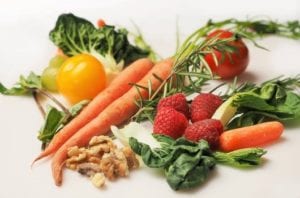Written by Taylor Woosley, Staff Writer. A healthy PURE diet score in the highest quartile was associated with a lower risk of total mortality (P-trend <0.0001), major CVD event (P-trend < 0.0001), and CVD mortality when compared to a healthy PURE diet score in the lowest quartile.
 Cardiovascular disease (CVD) is the leading cause of mortality worldwide1. Between 1990 and 2019, the number of CVD cases approximately doubled from 285 million to 523 million2. Systemic and local inflammation play a central role in the development of CVD, leading to endothelial dysfunction and atherosclerosis3.
Cardiovascular disease (CVD) is the leading cause of mortality worldwide1. Between 1990 and 2019, the number of CVD cases approximately doubled from 285 million to 523 million2. Systemic and local inflammation play a central role in the development of CVD, leading to endothelial dysfunction and atherosclerosis3.
The main cardiometabolic risk factors associated with CVD are diabetes, hypertension, dyslipidemia, and excess abdominal fat, which are all affected by dietary changes4. Unhealthy dietary patterns such as excessive intake of sodium, processed foods, added sugars, along with a lack of exercise, and excess smoking and alcohol consumption increase the probability of developing CVD5. Therefore, a high intake of plant foods including fruits, vegetables, whole grains, nuts, and legumes have long been recommended to reduce the risk of chronic diseases such as CVD6.
Mente et al. conducted a study using data from the Prospective Urban Rural Epidemiology (PURE) cohort of 147,642 subjects from 21 countries to create a healthy diet score and to examine the consistency of the cohort data with three independent prospective studies. The PURE study focused on subjects aged 35-70 years from the general population of 21 low-, middle-, and high-income countries. The healthy diet score of PURE was developed from the records of participants’ habitual food intake assessed via food frequency questionnaires (FFQ) and based on six food categories that are associated with a lower risk of mortality and include fruit, vegetables, legumes, nuts, fish, and dairy.
Analysis of the consistency of the associations of the PURE diet score was compared with the diets and cardiovascular events in 3 prospective studies with 43,834 vascular patients and 2 case-control studies of myocardial infarction (n = 26,191) or stroke (n = 26,930). Primary outcome measures of the included studies were major cardiovascular events and total mortality. Median duration of follow-up was 9.3 years in the PURE study and ranged from 4.5 to 6.2 years in the comparison studies. Restricted cubic-spline plots with four knots were utilized to examine the shape of the association between diet scores and risk of mortality and major CVD. For analysis of all six studies, a two-stage individual participant data meta-analysis was used. Significant findings of the study are as follows:
- Based on PURE diet scores, the healthiest diet consisted of 563.1 g/day (5 servings) of fruits and vegetables, 48.0 g/day (0.5 servings) of legumes, 28.2 g/day (1.2 servings) of nuts, 26.1 g/day (0.3 servings) of fish, 185.5 g/day (2 servings) of dairy (mainly whole-fat dairy), 54.5 g/day (0.5 servings) of red meat, and 22.1 g/day (0.3 servings) of poultry.
- Higher PURE healthy diet scores were associated with a lower risk of mortality, CVD events, myocardial infarction, stroke, and CVD mortality in the age, sex, and study center adjusted models (all P for trend < 0.001).
- A healthy PURE diet score in the highest quartile was associated with a lower risk of total mortality (P-trend <0.0001), major CVD (P-trend < 0.0001), myocardial infarction (HR = 0.86; 0.75–0.99), stroke (HR = 0.81; 0.71–0.93), CVD mortality (HR = 0.72; 0.60–0.85), non-CVD mortality (HR = 0.68; 0.60–0.78), and the composite of death or CVD (P-trend <0.0001) when compared to a healthy PURE diet score in the lowest quartile.
- Associations of the PURE healthy diet score with CVD and mortality events were similar across the four prospective studies (median follow-up of 8.3 years for major CVD, overall P < 0.0001, P = 0.845; for death, overall P < 0.0001, P = 0.405, and for composite of death or CVD, overall P < 0.0001, P = 0.461).
Results of the study analysis of four prospective cohort studies and two-case control studies of 244,597 subjects from 80 countries suggest that following a diet that consists of higher amounts of fruits, vegetables, nuts, legumes, and moderate intake of fish and whole-fat dairy is associated with a lower risk of CVD and mortality. Study limitations include potential incorrect diet information due to recall bias and the lack of examination of the role of individual fruits and vegetables. Further research should focus on understanding what specific types of fruits and vegetables provide cardioprotective benefits.
Source: Mente, Andrew, Mahshid Dehghan, Sumathy Rangarajan, Martin O’Donnell, Weihong Hu, Gilles Dagenais, Andreas Wielgosz et al. “Diet, cardiovascular disease, and mortality in 80 countries.” European Heart Journal 44, no. 28 (2023): 2560-2579.
Click here to read the full text study.
Posted August 28, 2023.
Taylor Woosley studied biology at Purdue University before becoming a 2016 graduate of Columbia College Chicago with a major in Writing. She currently resides in Glen Ellyn, IL.
References:
- Tyrovola D, Soulaidopoulos S, Tsioufis C, Lazaros G. The Role of Nutrition in Cardiovascular Disease: Current Concepts and Trends. Nutrients. Feb 21 2023;15(5)doi:10.3390/nu15051064
- Petersen KS, Kris-Etherton PM. Diet Quality Assessment and the Relationship between Diet Quality and Cardiovascular Disease Risk. Nutrients. Nov 28 2021;13(12)doi:10.3390/nu13124305
- Henein MY, Vancheri S, Longo G, Vancheri F. The Role of Inflammation in Cardiovascular Disease. Int J Mol Sci. Oct 26 2022;23(21)doi:10.3390/ijms232112906
- Diab A, Dastmalchi LN, Gulati M, Michos ED. A Heart-Healthy Diet for Cardiovascular Disease Prevention: Where Are We Now? Vasc Health Risk Manag. 2023;19:237-253. doi:10.2147/vhrm.S379874
- Casas R, Castro-Barquero S, Estruch R, Sacanella E. Nutrition and Cardiovascular Health. Int J Mol Sci. Dec 11 2018;19(12)doi:10.3390/ijms19123988
- Aune D. Plant Foods, Antioxidant Biomarkers, and the Risk of Cardiovascular Disease, Cancer, and Mortality: A Review of the Evidence. Advances in nutrition (Bethesda, Md). Nov 1 2019;10(Suppl_4):S404-s421. doi:10.1093/advances/nmz042
